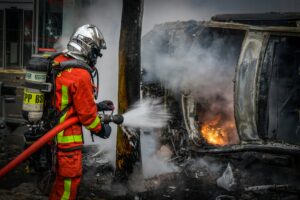From Buckets to High-Tech Tools: The Evolution of Firefighting Equipment and Technology


In the early days of firefighting, communities relied on the most basic firefighting equipment. People formed bucket brigades, passing containers of water from person to person in an urgent attempt to extinguish fires. This method was slow, exhausting, and often ineffective, but it represented a critical first step in organized firefighting. Even with such limitations, it united neighbors in a shared responsibility for safety.
Over time, these methods gave way to slightly more advanced tools like leather hoses and manual pumps. These upgrades allowed for delivering water directly to a blaze, reducing the time spent transferring buckets. While primitive by modern standards, these innovations laid the groundwork for the more sophisticated firefighting equipment in later centuries.
Rise of the Steam and Horse-Drawn Era
As cities grew during the Industrial Revolution, so did the demand for faster and more effective firefighting methods. The invention of the steam-powered fire engine in the 19th century revolutionized how firefighters approached emergencies. It could pump large amounts of water at greater pressure, making firefighting faster and more efficient. This technology also reduced the number of firefighters needed to manually pump water, allowing crews to focus on tackling the fire directly.
Horse-drawn carriages quickly became the standard way to transport these engines and other gear. The speed of horses compared to human foot travel allowed crews to reach fires more quickly. Although steam engines eventually became outdated, their introduction marked a turning point in firefighting, which began relying heavily on mechanical power rather than sheer human effort.
Motorized Vehicles and Modern Pumps
With the arrival of the 20th century, motorized fire engines replaced horse-drawn equipment. Gasoline-powered vehicles could carry heavier loads and travel faster, significantly improving emergency response times. Fire departments across the country adopted these vehicles, setting the stage for the specialized trucks we see today.
Modern pumps also evolved during this period, offering higher capacity and more reliable performance. Maintaining intense, continuous water pressure significantly increased the effectiveness of firefighting efforts. This technological shift allowed departments to tackle larger, more complex fires, from urban blazes to industrial incidents.
Protective Gear and Safety Innovations
As firefighting technology advanced, so did the protective equipment designed to keep firefighters safe. Early gear consisted mainly of wool or leather clothing, which offered little protection from heat, smoke, or falling debris. However, as the risks of firefighting became better understood, equipment evolved to include helmets, fire-resistant coats, and sturdy boots. These innovations gave firefighters greater protection while allowing them to work more effectively in dangerous environments.
In the late 20th century, self-contained breathing apparatus (SCBA) became standard. This technology allowed firefighters to enter smoke-filled buildings without inhaling toxic fumes. The addition of thermal imaging cameras further improved safety, enabling crews to see through thick smoke and locate trapped individuals more quickly. These tools have saved countless lives for firefighters and the people they rescue.
Communication and Coordination Tools
Effective communication has always been critical in firefighting. In the past, teams relied on shouts, hand signals, or basic whistles to relay information. These methods are often confused, especially in chaotic fire scenes. With the development of portable radios, crews could coordinate their actions in real time, even across large distances. This change dramatically improved teamwork and efficiency.
Today’s communication systems go even further, integrating GPS tracking, incident mapping, and live data sharing. Command centers can simultaneously monitor firefighter locations, environmental conditions, and equipment status. This level of coordination ensures that resources are deployed where needed most, reducing response times and increasing the likelihood of successful outcomes.
Robotics, Drones, and the Future of Firefighting
Recent years have brought cutting-edge technologies that would have seemed like science fiction a century ago. Drones now play a significant role in assessing fire scenes from above, providing aerial views without harming firefighters. These devices can detect hotspots, map fire spread, and deliver critical data within minutes.
Robotics is also making a strong entrance into the field. Remote-controlled firefighting robots can enter hazardous areas, suppress flames, and even clear debris, all while keeping human firefighters at a safe distance. As these technologies become more advanced and affordable, they will likely become a regular part of firefighting strategies worldwide.
A Continuing Legacy of Innovation
The evolution of firefighting technology and equipment has been remarkable, from hand-carried buckets to unmanned machines. Each advancement reflects a commitment to saving lives, protecting property, and improving safety for the public and the firefighters. This journey also highlights the importance of adapting to new challenges with creativity and determination.
As technology continues to advance, the tools and methods of firefighting will only become more effective. While the future may hold innovations we can barely imagine today, one thing remains constant: the bravery and dedication of firefighters who put these tools to use. In every era, their courage is what truly makes the difference.
